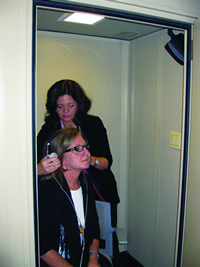Allegro
Visiting the audiologist
Volume 115, No. 4April, 2015

A special soundproof room helps audiologists test the hearing of musicians and other patients. Above, the audiologist is adjusting the headphones prior to the hearing test.
It is extremely important for every person to have a complete hearing evaluation to establish baseline hearing levels, at the very least. While this is important for everyone, it is most important for musicians who are extremely reliant on this sense to create and appreciate music and who are constantly exposed to noise.
Before the examination begins, it is important for the audiologist to sit down with patients and take a very comprehensive case history. There are a lot of factors that can influence hearing loss. These include medical conditions, family history, any history of noise exposure and any medications taken, to name a few. Patients are also asked to describe their symptoms, what type of problems they are experiencing and what is the motivating factor for having their hearing tested. The more information obtained during this personal intake, the better the ability of the audiologist to perform the necessary tests. In addition and equally as important, this conversation allows the audiologist to establish a rapport.
Next, the audiologist will do a physical exam of the ear itself, with an otoscope. This is necessary to see if there is wax, an infection or any other physical issue. Patients are then seated in a soundproof booth (see photo above). They put on earphones and are asked to respond when they hear a sound. The sound is initially presented at a level that is loud enough for patients to hear. The sound is then decreased in loudness level in various steps until the lowest level that patients can hear sound is determined. That is known as the audiometric threshold. This testing is done for both ears separately and for frequencies ranging from low to high. The same threshold testing is employed using a small box-like item placed behind the ear (known as a bone conduction oscillator) to see how well the nerve hears by directly stimulating the cochlea (the sensory organ of hearing). Once the hearing thresholds have been obtained, a series of words is presented to the patient to determine the lowest level that words can be heard and repeated back. Another list of words is again presented at higher loudness level in order to ascertain how clearly a patient hears speech.
Objective tests which do not require patients to respond are also incorporated into the initial evaluation. A test is administered to determine whether the ear drum is moving properly and if there are any medical conditions present in the middle ear which would not allow for the proper transmission of sound to the cochlea. This is known as immittance testing. Another test (known as an otoacoustic emissions test) is administered to determine whether there is damage to the outer hair cells of the cochlea.
Once all of the testing is completed, the audiologist will explain the results to the patient and make the appropriate recommendations for treatment. The explanation of the hearing loss should include the type of hearing loss, the severity of hearing loss, the areas where the loss occurs, information regarding the way a patient understands speech and information about the physical condition of the ear. Patients should be appropriately counseled as to whether medical intervention is necessary, whether they would benefit from the use of amplification or the use of custom ear protection, and what difficulties should be expected with their particular loss of hearing.
If hearing devices are recommended, many factors need to be considered to determine the best choice for the patient. It is most important for the audiologist to listen to the patient and involve them in the decision-making process. Considerations include the patient’s hearing loss, listening needs, lifestyle, manual dexterity, and financial and cosmetic concerns. Patients need to be educated as to the different styles of hearing devices and the different levels of technology that are available. Pricing must be discussed and what type of follow-up care is recommended. It should be determined whether one or two devices are necessary, keeping in mind that using two hearing devices provide better overall hearing, especially with regard to listening in background noise. Realistic goals and expectations must be established for the patient and they must be counseled accordingly.
Dr. Ellen Finkelstein is the chief audiologist at Eastside Audiology in New York City (www.EastSideHearing.com).
